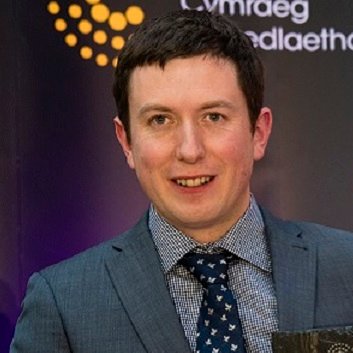Research
My research interests are mainly in modelling complex fluids such as aqueous foams,
materials that are widely used domestically and in industry.
Most of my reseach so far uses a quasi-static model and the Surface Evolver
software for bubble-scale simulations of foams. In particular, I have focused on studying how thin films and foams interact with solid objects, a process
that is important in applications such as mineral separation by froth flotation.
PhD Projects
Contact me if you're interested in possible PhD projects in the above field. Suitable students
will have a background in applied mathematics or related fields and some programming experience.
Research Articles
I.T. Davies and C. Raufaste (2021).
Effect of gravity on the orientation and detachment of cubic particles adsorbed at soap film or liquid interfaces. Soft Matter, 17, 6964-6971.
Preprint
S.J. Cox and I.T. Davies (2021).
The evolution of numerical methods for predicting the distribution of surfactant in the bubble-scale
dynamics of foams. Curr. Opin. Coll. Interf. Sci. 53, June 2021, 101440.
Preprint
S.J. Cox and I.T. Davies (2020).
Bubble entrainment by a sphere falling through a horizontal soap foam.
EPL. 130: 14002.
Preprint
I.T. Davies (2018).
Simulating the interaction between a descending super-quadric solid object and a soap film. P Roy Soc A-Math Phy, 474(2218), p.20180533.
Draft (pdf) version
S.J. Cox and I.T. Davies (2016).
Simulations of quasi-static foam flow through a diverging-converging channel. Korea-Australia Rheology Journal 28: 181.
Draft (pdf) version
I.T. Davies, L. Garratt and S.J. Cox (2015).
Rhaniad arwynebedd lleiaf silindr yn dair rhan. Gwerddon, 20, Hydref 2015, 30-43.
Draft (pdf) version
D.R. Lipsa, R.S. Laramee, S.J. Cox and I.T. Davies (2013).
Visualizing 3D Time-Dependent Foam Simulation Data.
Advances in Visual Computing, Lecture Notes in Computer Science,
8033:255-265.
Preprint
I.T. Davies, S.J. Cox and J. Lambert (2013).
Reconstruction of tomographic images of dry aqueous foams. Coll. Surf. A,
438:33-40.
Preprint
S.J. Cox, D.R. Lipsa, I.T. Davies and R.S. Laramee (2013).
Visualizing the dynamics of two-dimensional foams with FoamVis. Coll. Surf. A
438:28-32.
Preprint
I.T. Davies and S.J. Cox (2012).
Sphere motion in ordered three-dimensional foams. Journal of Rheology
56:473-483.
Preprint
D.R. Lipsa, R.S. Larammee, S.J. Cox and I.T. Davies (2011).
FoamVis: Visualization of 2D Foam Simulation Data. IEEE Transactions on Visualization and Computer Graphics
17:2096-2105.
Preprint
I.T. Davies and S.J. Cox (2010).
Sedimentation of an elliptical object in a two-dimensional foam. J. Non-Newt. Fl. Mech.
165:793-799.
Preprint
I.T. Davies and S.J. Cox (2009).
Sedimenting discs in a two-dimensional foam. Coll. Surf. A
344:8-14.
Draft (pdf) version.
A. Wyn, I.T. Davies and S.J. Cox (2008).
Simulations of two-dimensional foam rheology: localization in linear Couette flow and the interaction of settling discs . Euro. Phys. J. E
26:81-89.
Draft (pdf) version.
Outreach
I offer the following sessions to schools as part of the outreach activities of the Department of Mathematics:
Mathematics with Bubbles
A foam or a cluster of bubbles naturally minimize their total surface area, and as a result their structure obeys some
mathematical rules (such as
Platerau's laws and the Laplace-Young law). In this presentation, we will visually observe these mathematical rules.
We will go on to use bubbles to solve the
Steiner Problem. The objective of this problem is to connect sites such as cities together in the most efficient way,
that is by building the shortest possible set of roads or railway track.
This presentation includes trigonomteric calculations, using Pythagoras' theorem, and some differentiation. It can be adapted so that it is suitable to learners from any
secondary school year. The presentation has been adapted to a
website due to Covid-19 restrictions on school visits.
Mathematics and Sport
I also have a keen interests in many types of sport. There are many problems in sport which can be thought of in terms of mathematics, for example:
- Geometry in Rugby
From which spot should a kicker choose to attempt to convert a try? Maybe that he or she should try to make the angle between the posts as large as possible.
To solve this problem, we will need to use our knowledge of geometry.
- Algebra and Calculus in Motor Racing
How many times should an F1 driver pit during a race and when? To decide on the optimal strategy, we will need to
revisit sequences and series, and we will possibly need some differentiation.
- Probability in Football
You can consider a penalty shootout at the end of a cup-tie as a sequence of two person zero-sum games! The goalkeeper wishes to maximise his/her
chance of saving a penalty while the kicker tries to maximise his/her chance of scoring.

